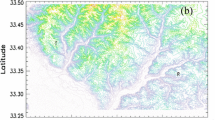Abstract
The pulsing inertial oscillation (PIO) model is a nonlinear, time-dependent, translating vortex solution of the inviscid, compressible fluid dynamic equations in the middle troposphere. The translation of this vortex during a pulse is strikingly similar to that of a supercell storm – a rotating thunderstorm that can generate tornadoes and hail. Two studies were performed to test the hypothesis that some supercell storms are manifestations of a PIO pulse. The first study applied the model to an intense interior draft whose buoyancy was bounded by a temperature excess of ± 12 K. The peak updraft speed achieved was 41·5 m s−1 and the peak Rossby number was 92·9. The study also pointed to an advanced concept for attaining higher values. The second study applied the PIO model to a supercell storm as a whole and succeeded in replicating its bulk properties, such as mesocylonic circulation, net mass and moisture influxes, and time track. This study also identified a critical feature of the PIO model that could be tested against storm data: The average vertical draft is downward before the turn in the storm track and upward afterwards. In the conventional theory, the average vertical draft is upward from storm inception until dissipation. These differing draft predictions were compared with the best available data, which are surface mesonetwork data. These data were found to support the PIO model. However, surface data alone are not conclusive, and further measurements are warranted.
Similar content being viewed by others
References
T. Fujita and H. Grandoso, Split of a thunderstorm into anticyclonic and cyclonic storms and their motion as determined from numerical model experiments. J. Atmos. Sci.25 (1968) 416-439.
W. Ferrel, A Popular Treatise on the Winds. New York: John Wiley (1889) 505 pp.
J. M. Wallace and P. V. Hobbs, Atmospheric Science, An Introductory Survey. New York: Academic Press (1977) 467 pp.
B. R. Morton, Geophysical vortices. Progress in Aeronautical Sciences, Vol. 7, (D. Kuchemann, ed.). Pergamon Press (1966) 145-194.
J. R. Holton, An Introduction to Dynamic Meteorology.Third edition. New York: Academic Press (1992) 511 pp.
R. P. Davies-Jones, Tornado dynamics. Thunderstorm Morphology and Dynamics. Second Edition. (E. Kessler, ed.) vol. 2. Thunderstorms: A Social, Scientific, and Technological Documentary. Univ. of Oklahoma Press. London (1986) 197-236.
L. Bengtsson and J. Lighthill (eds.), Intense Atmospheric Vortices. Heidelberg: Springer-Verlag (1982) 326 pp.
E. Kessler (ed.), Thunderstorm Morphology and Dynamics. Second edition. Vol. 2. Thunderstorms: A Social, Scientific, and Technological Documentary. Univ. of Oklahoma Press. London (1986).
P. S. Ray (ed.), Mesoscale Meteorology and Forecasting. Amer. Meteor. Soc. (1986) 793 pp.
J. B. Klemp, Dynamics of tornadic thunderstorms. Ann. Rev. Fluid Mech.19 (1987) 369-402.
C. Church, D. Burgess, C. Doswell, and R. Davies-Jones (eds.), The Tornado: Its Structure, Dynamics, Prediction, and Hazards. Geophysical Monograph 79. American Geophysical Union (1993) 637 pp.
R. E. Schlesinger, A three-dimensional numerical model of an isolated deep thunderstorm. Part II: Dynamics of updraft splitting and mesovortex couplet evolution. J. Atmos. Sci. 37 (1980) 395-420.
R. A. Brown, Initiation and evolution of updraft rotation within an incipient supercell thunderstorm. J. Atmos. Sci. 49 (1992) 1997-2014.
R. A. Maddox, An evaluation of tornado proximity wind and stability data. Mon. Wea. Rev.104 (1976) 133-142.
J. B. Klemp and R. B. Wilhelmson, Simulations of right-and left-moving storms produced through storm splitting. J. Atmos. Sci. 35 (1978) 1097-1110.
D. K. Lilly, The development and maintenance of rotation in convective storms. In: L. Bengtsson and J. Lighthill (eds.), Intense Atmospheric Vortices. Heidelberg: Springer-Verlag (1982) 149-160.
L. J. Wicker and R. B. Wilhelmson, Simulation and analysis of tornado development and decay within a three-dimensional supercell thunderstorm. J. Atmos. Sci. 52 (1995) 2675-2703.
R. C. Costen and L. V. Stock, Inertial oscillation of a vertical rotating draft with application to a supercell storm. NASA TP-3230 (1992) 47 pp. with 8-minute video supplement available.
G. B. Foote and J. C. Fankhauser, Airflow and moisture budget beneath a northeast Colorado hailstorm. J. Appl. Meteor. 12 (1973) 1330-1353.
J. C. Fankhauser, G. M. Barnes, L. J. Miller, and P. M. Roskowski, Photographic documentation of some distinctive cloud forms observed beneath a large cumulonimbus. Bull. Amer.Meteor. Soc. 64 (1983) 450-462.
C. A. Knight (ed.), The cooperative convective precipitation experiment (CCOPE), 18 May-7 August 1981. Bull. Amer. Meteor. Soc. 63 (1982) 386-398.
C. G. Wade, A quality control program for surface mesometeorological data. J. Atmos. Ocean. Technol. 4 (1987) 435-453.
L. J. Miller, J. D. Tuttle, and C. A. Knight, Airflow and hail growth in a severe northern high plains supercell. J. Atmos. Sci. 45 (1988) 736-762.
R. Rotunno and J. B. Klemp, The influence of the shear-induced pressure gradient on thunderstorm motion. Mon. Wea. Rev.110 (1982) 136-151.
D. K. Lilly, The structure, energetics and propagation of rotating convective storms. Part II: Helicity and storm stabilization. J. Atmos. Sci. 43 (1986) 126-140.
W. Menke and D. Abbott, Geophysical Theory. New York: Columbia Univ. Press (1990) 458 pp.
G. J. Haltiner and F. L. Martin, Dynamical and Physical Meteorology. New York: McGraw-Hill (1957) 470 pp.
E. A. Brandes, Finestructure of the Del City-Edmond tornadic mesocirculation. Mon. Wea. Rev.109 (1981) 635-647.
G. L. Darkow, Basic thunderstorm energetics and thermodynamics. In: E. Kessler (ed.), Thunderstorm Morphology and Dynamics. Second edition. vol. 2. Thunderstorms: A Social, Scientific, and Technological Documentary. London: Univ. of Oklahoma Press (1986) 59-73.
M. Urabe, Nonlinear Autonomous Oscillations. New York: Academic Press (1967) 330 pp.
C. W. Newton and H. R. Newton, Dynamical interactions between large convective clouds and environment with vertical shear. J. Meteor. 16 (1959) 483-496.
R. Davies-Jones, Useful formulas for computing divergence, vorticity, and their errors from three or more stations. Mon. Wea. Rev.121 (1993) 713-725.
Author information
Authors and Affiliations
Rights and permissions
About this article
Cite this article
Costen, R.C., Miller, L.J. Pulsing Interial Oscillation, Supercell Storms, and Surface Mesonetwork Data. Journal of Engineering Mathematics 34, 277–300 (1998). https://doi.org/10.1023/A:1004319330013
Issue Date:
DOI: https://doi.org/10.1023/A:1004319330013




